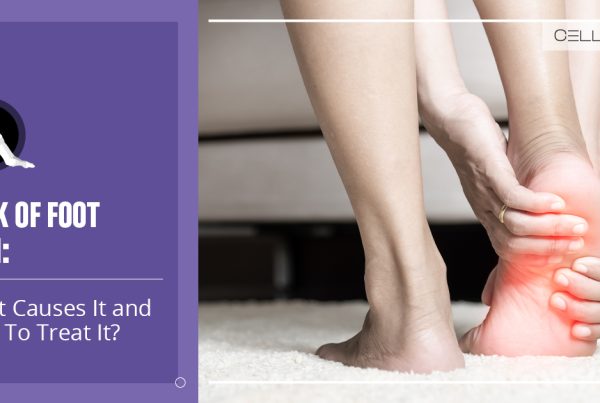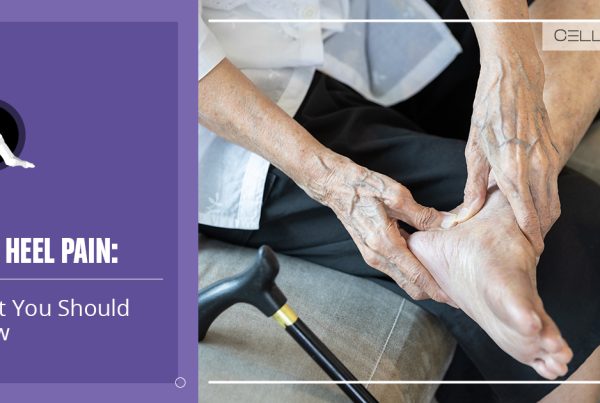Published on: November 4, 2019 | Updated on: August 29, 2024
The ankles are a delicate mix of some of the smallest, most intricate pockets of cartilage, ligament, tendon, muscle, and bone within the human body.
Though the ankles are small compared to the rest of the human body, they sustain the most burden and are therefore some of the most susceptible to an injury.
If even a small portion of the ankle is injured, this can affect the mechanics and interaction between each of the other tissues, leading to several adverse symptoms. One of the most common of these symptoms is numbness around the ankle. This numbness can be a sign of one of several degenerative illnesses or a deeper injury within the ankle.
Why Are My Ankles Going Numb?
Numb ankles can be caused by one of several factors. An injury that has failed to heal properly, the onset of arthritis or osteoarthritis, pinched nerves or arteries, and many other less common issues may lead to numbness of the ankle and its surrounding tissues.
Along with numbness, an individual may typically experience a tingling or burning sensation as they use the ankle more and more. These signs demonstrate a weakening ankle and can lead to lesser load-bearing ability. Over time, these issues may worsen and leave a person’s ankle fully immobile.
The sets of tissues most commonly associated with ankle numbness are the major ligaments and major muscles. Due to the intricate system of tissues, when one breaks down, this weakens the stability of the entire ankle leading to imbalance and eventually break down of the cartilage within the ankle and the swelling which eventually causes numbness.
These include:
Major Ankle Ligaments
- The lateral ligament complex is made up of the “anterior talofibular ligament” (ATFL), the “calcaneofibular ligament” (CFL), and the “posterior talofibular ligament” (PTFL). These ligaments help support the intricate bone structures within the ankle by connecting them.
- The “deltoid ligament” provides support to movements towards the inner side of the ankle.
- The “anterior inferior tibiofibular ligament” (AITFL), is a connective ligament between the tibia and the fibula.
- The “posterior inferior tibiofibular ligament” (PITFL) and “transverse ligament” cross together to support pressure applied to the back of the ankle.
This intricate network of ligaments surrounds and supports the ankle and helps provide fluidity to its movements as well as controls the force applied throughout the ankle.
Major Ankle Muscles
- Known as “peroneal muscles”, the peroneus longus and peroneus brevis provide the force necessary for the ankle to bend perpendicular to the leg. These muscles are nested on the outside of the foot and ankle.
- In addition to the peroneal muscles, the “calf muscles” known as the gastrocnemius and soleus help stimulate ankle movements downward and upward by connecting to the achilles tendon within the ankle.
- Finally, the “posterior tibialis” and “anterior tibialis” muscles enable inward (closer to the center of the body) and outward (away from the center of the body) movements.
This complex system of ligaments and muscles creates an abundance of opportunities for injury or degeneration which can lead to numbness as the soft tissue structures devolve. As these tissues break down, further complications can ensue, though periodic numbness is often one of the first symptoms of these much larger issues.
How Did This Start?

Due to the intricate nature of the tissues within the ankle, it can be hard to pinpoint a precise cause for an individual’s ankle numbness. Injuries that fail to heal properly, even those which seem minor, can develop into major issues that lead to a feeling of numbness or tingling within the ankle.
Other issues that can lead to a numb ankle include degenerative illnesses such as arthritis and osteoarthritis. These degenerative illnesses cause tissues to break down within the ankle leading to swelling. This swelling constricts the nerves within the joint and leads to the feeling of numbness around the ankle.
To properly deduce the inciting factors of numbness, doctors usually have to examine the person’s medical history, perform a physical inspection of the ankle, and follow all of this up with medical imaging such as MRIs, CAT scans, and X-rays.
This dive into a patient’s medical history and subsequent examinations will help a doctor pinpoint the tissues which may be at fault and develop a plan to combat the progression of the symptoms. If numbness in the ankle is persistent or if episodes become worse over time, it may be time to seek out a medical examination.
Will the Numbness Get Worse?
Numbness may become exponentially worse if not treated promptly. As tissues wear away, symptoms will begin to express themselves more fully – episodes of numbness will become longer, weakness and instability will get worse, and eventually, immobility may set in.
Symptoms such as numbness will develop more quickly in a patient who has suffered an injury than one who has a degenerative illness such as arthritis, but unlike degenerative illnesses, these symptoms will typically “bottom out” at a certain point and cease getting worse.
Symptoms from degenerative illnesses typically take years to manifest, but the problem is, once they do express themselves, they will continually get worse until the tissues are completely gone. As the body gets older, its healing factor wanes, and thus its natural ability to combat the degeneration brought on by arthritis wanes as well.
Fortunately, new medicines are being created every day that not only help combat the progression of degeneration but also help to restore the tissues which were lost. These radical treatments are not new, they’ve been studied for over half a century and are continuing to be developed to this day.
Treatments such as autologous stem cell and PRP therapy are creating new hope for those combatting issues such as chronically numb ankles.
Treating Ankle Numbness With Regenerative Therapy
Unlike conventional treatments such as medication, physical therapy, and surgery, regenerative therapies aim to combat the symptoms of degenerative injuries and their underlying root causes.
Orthobiologic methods, such as cell-based and PRP therapies, have been shown to help boost the body’s response to degenerative illnesses and restore lost tissues. They involve extracting cells and tissues directly from a patient, processing them, then reinjecting them back into the patient.
This accelerates the growth factors and the healing process and provides an environment suitable for repairs.
PRP Therapy
Platelet-rich plasma (PRP) therapy extracts blood from a patient and isolates the platelets from the plasma, which are then reinjected into the patient’s injury site. Platelets are responsible for forming the clots to stop bleeding and create chemical impulses that trigger a healing response from the body.
They release 10 Growth Factors and form a sticky web-like structure called fibrin to stimulate the growth of new, healthy cells. PRP is completed in about 45 minutes. This treatment has been around for decades and is prominent amongst professional athletes and celebrities.
Cell-Based Therapies
Cell-based therapies are commonly called stem cell therapies. There are two types of cell-based therapies we perform at CELLAXYS:
- Minimally Manipulated Adipose Tissue transplant (MMAT). It includes harvesting healthy cells from your adipose (fat) tissue and injecting them into the affected part of your ankles. MMAT can be performed in different areas in the same procedure.
- Bone Marrow Concentrate (BMAC). This procedure extracts highly concentrated cells from your bone marrow and reinjects them into the injury site.
Both types of cell-based therapies are performed under anesthesia. The doctor uses a live X-ray and ultrasound to identify the exact transplant location. They are outpatient procedures, which means you can go home after the treatment.
These procedures take about 1.5-2 hours to complete.
Sources
Footnotes
- Sidey JD. Weak ankles. A study of common peroneal entrapment neuropathy. British Medical Journal. 1969;3(5671):623-6.
- Ko SU, Simonsick EM, Jerome GJ, Palchamy E, Ferrucci L. Longitudinal and Cross-Sectional Association Between Gait Speed, Ankle Proprioception, and LE Numbness—Results From the Baltimore Longitudinal Study of Aging. Journal of Aging and Physical Activity. 2022;31(3):453-7.
- Nickisch F, Barg A, Saltzman CL, Beals TC, Bonasia DE, Phisitkul P, Femino JE, Amendola A. Postoperative complications of posterior ankle and hindfoot arthroscopy. JBJS. 2012;94(5):439-46.
- Llanos LF, Vila J, Nunez-Samper M. Clinical symptoms and treatment of the foot and ankle nerve entrapment syndromes. Foot and Ankle Surgery. 1999;5(4):211-8.
- Killian RB, Nishimoto GS, Page JC. Foot and ankle injuries related to rock climbing. The role of footwear. Journal of the American Podiatric Medical Association. 1998;88(8):365-74.
References
- Numbness. MSD Manuals. Accessed 2/26/2024.
- Why are my legs and feet numb?. Medical News Today. Accessed 2/26/2024.
- What Is Degenerative Disk Disease?. WebMD. Accessed 2/26/2024.
CELLAXYS does not offer Stem Cell Therapy as a cure for any medical condition. No statements or treatments presented by Cellaxys have been evaluated or approved by the Food and Drug Administration (FDA). This site contains no medical advice. All statements and opinions are provided for educational and informational purposes only.
Dr Pejman Bady
Author
Dr. Pejman Bady began his career over 20 years ago in Family/Emergency Medicine, working in fast-paced emergency departments in Nevada and Kansas. He has served the people of Las Vegas as a physician for over two decades. Throughout this time, he has been met with much acclaim and is now the head of Emergency Medical Services in Nye County, Nevada. More about the doctor on this page.
Dr Pouya Mohajer
Contributor
Pouya Mohajer, M.D. is the Director of Spine and Interventional Medicine for CELLAXYS: Age, Regenerative, and Interventional Medicine Centers. He has over 20 years of experience in pain management, perioperative medicine, and anesthesiology. Dr. Mohajer founded and is the Medical Director of Southern Nevada Pain Specialists and PRIMMED Clinics. He has dedicated his career to surgical innovation and scientific advancement. More about the doctor on this page.









